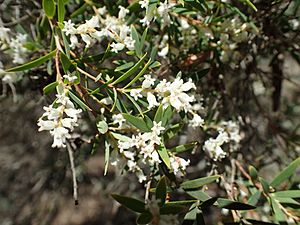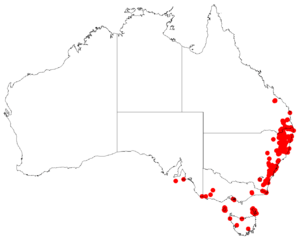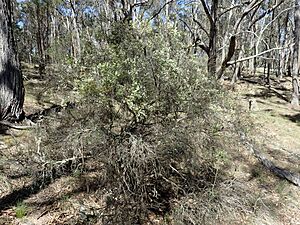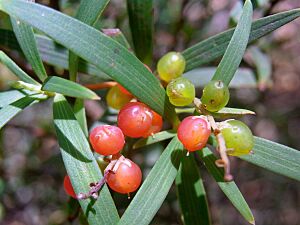Lance beard-heath facts for kids
Quick facts for kids Lance beard-heath |
|
|---|---|
 |
|
| Leucopogon affinis leaves and flowers | |
| Scientific classification | |
| Genus: |
Leucopogon
|
| Species: |
affinis
|
 |
|
| Occurrence data from AVH | |
| Synonyms | |
|
|
The Leucopogon affinis, often called lance beard-heath, is a type of flowering plant. It belongs to the heath family, called Ericaceae. This plant is special because it grows only in eastern Australia, including Tasmania and South Australia.
It is a tall, upright bush that produces small white flowers in early spring. After the flowers, it grows orange-red fruits.
What it Looks Like
The lance beard-heath is usually a bushy plant that stands upright. It can grow to be about 0.7 to 3 meters tall, which is like the height of a tall person or a small tree. Its youngest branches might have tiny hairs on them.
The leaves of this plant are shaped like a spear, an oval, or an egg. They are usually between 6 and 50 millimeters long and 1.3 to 8 millimeters wide. This means they can be as short as your fingernail or as long as your thumb. The leaves are almost directly attached to the stem, with a narrow base and a pointed tip. If you look closely at the underside of the leaves, you might see fine lines. Sometimes, the edges of the leaves have tiny teeth near the tip.
The flowers grow in groups called spikes. These spikes appear at the ends of the branches and where the upper leaves meet the stem. Each spike can be from 3 to 39 millimeters long and hold between 2 and 16 white, tube-shaped flowers. The flower tube itself is about 3 to 4 millimeters long, which is very small. It has 5 pointed parts that are very hairy inside. At the base of the flower tube are narrow, egg-shaped leaves called sepals, which are about 1 to 2 millimeters long.
This plant flowers from August to October. After flowering, it produces smooth, oval-shaped, reddish-orange fruits. These fruits are about 3 millimeters long and can be eaten.

How it Got its Name
The plant Leucopogon affinis was first officially described by a botanist named Robert Brown in 1810. He published his description in a book called Prodromus Florae Novae Hollandiae.
The second part of its name, affinis, comes from a Latin word. It means "related to," "neighboring," or "bordering."
This plant used to be known by a different name, Leucopogon lanceolatus. However, plant experts now consider that name incorrect.
Where it Grows
The lance beard-heath mostly grows in open forests and woodlands. You can sometimes find it in wet valleys or swampy areas. It can grow in many different types of soil.
This plant is found in south-east Queensland, along the coast and nearby mountains of New South Wales, in the far south-eastern part of South Australia, and on some islands in Bass Strait. However, it does not grow on the main island of Tasmania.
-
L. affinis in the Royal National Park




